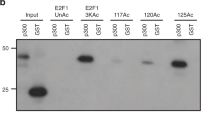Abstract
Double-strand DNA breaks (DSBs) induced by ionizing radiation can be visualized in human cells using antibodies against Ser-139 phosphorylated histone H2AX (γ-H2AX). Large γ-H2AX foci are seen in the nucleus fixed 1 hour after irradiation and their number corresponds to the number of DSBs, allowing analysis of these genome lesions after low doses. We estimated whether transcription is affected in chromatin domains containing γ-H2AX by following in vivo incorporation of 5-bromouridine triphosphate (BrUTP) loaded by cell scratching (run-on assay). We found that BrUTP incorporation is strongly suppressed at γ-H2AX foci, suggesting that H2AX phosphorylation inhibits transcription. This is not caused by preferential association of γ-H2AX foci with constitutive or facultative heterochromatin, which was visualized in irradiated cells using antibodies against histone H3 trimethylated at lysine-9 (H3-K9m3) or histone H3 trimethylated at lysine-27 (H3-K27m3). Apparently, formation of γ-H2AX induces changes of chromatin that inhibit assembly of transcription complexes without heterochromatin formation. Inhibition of transcription by phosphorylation of histone H2AX can decrease chromatin movement at DSBs and frequency of misjoining of DNA ends.
Similar content being viewed by others
References
Aten JA, Stap J, Krawczyk PM et al. (2004) Dynamics of DNA double-strand breaks revealed by clustering of damaged chromosome domains. Science 303: 92–95.
Casafont I, Navascues J, Pena E, Lafarga M, Berciano MT (2006) Nuclear organization and dynamics of transcription sites in rat sensory ganglia neurons detected by incorporation of 5′-fluorouridine into nascent RNA. Neuroscience 140: 453–462.
Chadwick BP, Willard HF (2004) Multiple spatially distinct types of facultative heterochromatin on the human inactive X chromosome. Proc Natl Acad Sci USA 101: 17450–17455.
Dundr M, Hoffmann-Rohrer U, Hu Q et al. (2002) A kinetic framework for a mammalian RNA polymerase in vivo. Science 298: 1623–1626.
Fink M, Imholz D, Thoma F (2007) Contribution of the serine 129 of histone H2A to chromatin structure. Mol Cell Biol 27: 3589–3600.
Fortune JM, Osheroff N (2000) Topoisomerase II as a target for anticancer drugs: when enzymes stop being nice. Prog Nucleic Acid Res Mol Biol 6: 221–253.
Franco S, Gostissa M, Zha S et al. (2006) H2AX prevents DNA breaks from progressing to chromosome breaks and translocations. Mol Cell 21: 201–214.
Kim JS, Krasieva TB, LaMorte V, Taylor AM, Yokomori K (2002) Specific recruitment of human cohesin to laser-induced DNA damage. J Biol Chem 277: 45149–45153.
Kimura H, Sugaya K, Cook PR (2002) The transcription cycle of RNA polymerase II in living cells. J Cell Biol 159: 777–782.
Kruhlak MJ, Celeste A, Dellaire G et al. (2006) Changes in chromatin structure and mobility in living cells at sites of DNA double-strand breaks. J Cell Biol 172: 823–834.
Ljungman M, Zhang F, Chen F, Rainbow AJ, McKay BC (1999) Inhibition of RNA polymerase II as a trigger for the p53 response. Oncogene 18: 583–592.
Lowndes NF, Toh GW (2005) DNA repair: the importance of phosphorylating histone H2AX. Curr Biol 15: R99–R102.
Mischo HE, Hemmerich P, Grosse F, Zhang S (2005) Actinomycin D induces histone gamma-H2AX foci and complex formation of gamma-H2AX with Ku70 and nuclear DNA helicase II. J Biol Chem 280: 9586–9594.
Nazarov IB, Smirnova AN, Krutilina RI et al. (2003) Dephosphorylation of histone gamma-H2AX during repair of DNA double-strand breaks in mammalian cells and its inhibition by calyculin A. Radiat Res 160: 309–317.
Rogakou EP, Pilch DR, Orr AH, Ivanova VS, Bonner WM (1998) DNA double-stranded breaks induce histone H2AX phosphorylation on serine 139. J Biol Chem 273: 5858–5868.
Rogakou EP, Boon C, Redon C, Bonner WM (1999) Megabase chromatin domains involved in DNA double-strand breaks in vivo. J Cell Biol 146: 905–916.
Sadoni N, Zink D (2004) Nascent RNA synthesis in the context of chromatin architecture. Chromosome Res 12: 439–451.
Schermelleh L, Solovei I, Zink D, Cremer T (2001) Two-color fluorescence labeling of early and mid-to-late replicating chromatin in living cells. Chromosome Res 9: 77–80.
Schotta G, Lachner M, Sarma K et al. (2004). A silencing pathway to induce H3-K9 and H4-K20 trimethylation at constitutive heterochromatin. Genes Dev 18: 1251–1262.
Siino JS, Nazarov IB, Zalenskaya IA, Yau PM, Bradbury EM, Tomilin NV (2002) End-joining of reconstituted histone H2AX-containing chromatin in vitro by soluble nuclear proteins from human cells. FEBS Lett 527: 105–108.
Tomilin NV, Solovjeva LV, Svetlova MP et al. (2001) Visualization of focal nuclear sites of DNA repair synthesis induced by bleomycin in human cells. Radiat Res 156: 347–354.
van Driel R, Fransz P (2004) Nuclear architecture and genome functioning in plants and animals: what can we learn from both? Exp Cell Res 296: 86–90.
Verschure PJ, van Der Kraan I, Manders EM, van Driel R (1999) Spatial relationship between transcription sites and chromosome territories. J Cell Biol 147: 13–24.
Williams RS, Tainer JA (2005) A nanomachine for making ends meet: MRN is a flexing scaffold for the repair of DNA double-strand breaks. Mol Cell 19: 724–726.
Author information
Authors and Affiliations
Corresponding author
Rights and permissions
About this article
Cite this article
Solovjeva, L.V., Svetlova, M.P., Chagin, V.O. et al. Inhibition of transcription at radiation-induced nuclear foci of phosphorylated histone H2AX in mammalian cells. Chromosome Res 15, 787–797 (2007). https://doi.org/10.1007/s10577-007-1162-x
Received:
Revised:
Accepted:
Published:
Issue Date:
DOI: https://doi.org/10.1007/s10577-007-1162-x




